Albania
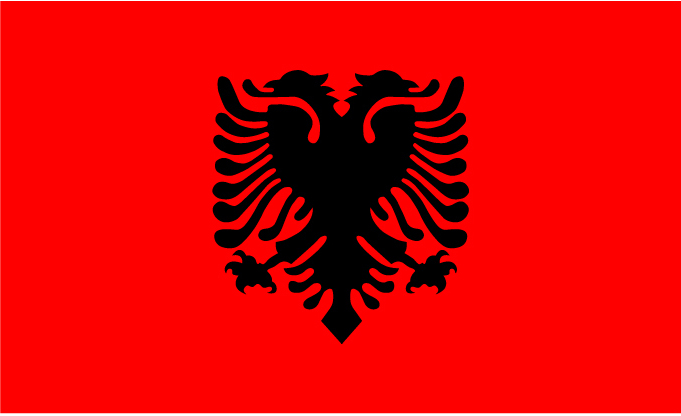
| Government | |
| Name | Republic of Albania |
| Albanian | Republika e Shqipërisë |
| Government type | Parliamentary republic |
| Capital | Tirana (494,000 (2020)) |
| Currency | Lek (ALL) |
| People | |
| Population (2020) | 2,877,800 (136th) |
| Density of population | 106 P/km2 |
| Nationality | Albanian |
| Official languages1 | |
| Albanian | 98.8% |
| Ethnic groups | |
| Albanian | 82.6% |
| Greek | 0.9% |
| Other | 1% |
| Unspecified | 15.5% |
| Religion | |
| Muslim | 56.7% |
| Roman Catholic | 10% |
| Orthodox | 6.8% |
| Atheist | 2.5% |
| Bektashi (a sufi order) | 2.1% |
| Other | 5.7% |
| Unspecified | 16.2% |
| Life expectancy (2020) | |
| Male | 76.3 years |
| Female | 81.9 years |
| Total population | 79 years (61st) |
| Homicides | |
| Total (2018) | 2.3 per 100,000 people (99th) |
| Literacy | |
| Definition: age 15 and over can read and write | |
| Male | 98.5% |
| Female | 97.8% |
| Total population | 98.1% |
| Geography | |
| Land area | 27,398 km2 |
| water area | 1,350 km2 |
| total area | 28,748 km2 (145th) |
| Mean elevation | 708 m |
| Lowest point | |
| Adriatic Sea | 0 m |
| Highest point | |
| Maja e Korabit (Golem Korab) | 2,764 m |
| Land use (2016) | |
| Agricultural land | 43.1% |
| Arable land | 22.6% |
| Permanent crops | 3% |
| Permanent pasture | 17.5% |
| Forest | 28.12% |
| Other | 28.75% |
| Urbanization | |
| Urban population (2020) | 62.1% |
| Rate of urbanization | 1.69% annual rate of change (2015 – 2020) |
| Economy | |
| Labor force (2017) | 1.198 million (140th) |
| Agriculture | 41.4% |
| Industry | 18.3% |
| Services | 40.3% |
| Unemployment rate (2017) | 13.8% (168th) |
| GDP (PPP) (estimate 2020) | |
| Total | $42.594 billion |
| Per capita | $14,866 |
| GDP (nominal) (estimate 2020) | |
| Total | $16.753 billion |
| Per capita | $5,847 |
| GDP by sector (estimate 2017) | |
| Agriculture | 21.7% |
| Industrie | 24.2% |
| Services | 54.1% |
| Exports (2017) | $900.7 million (164th) |
| Exports partners (2017) | |
| Italy | 53.4% |
| Kosovo | 7.7% |
| Spain | 5.6% |
| Greece | 4.2% |
| Imports (2017) | $4.103 billion (138th) |
| Imports partners (2017) | |
| Italy | 28.5% |
| Turkey | 8.1% |
| Germany | 8% |
| Greece | 8% |
| China | 7.9% |
| Serbia | 4% |
Albania on the world map
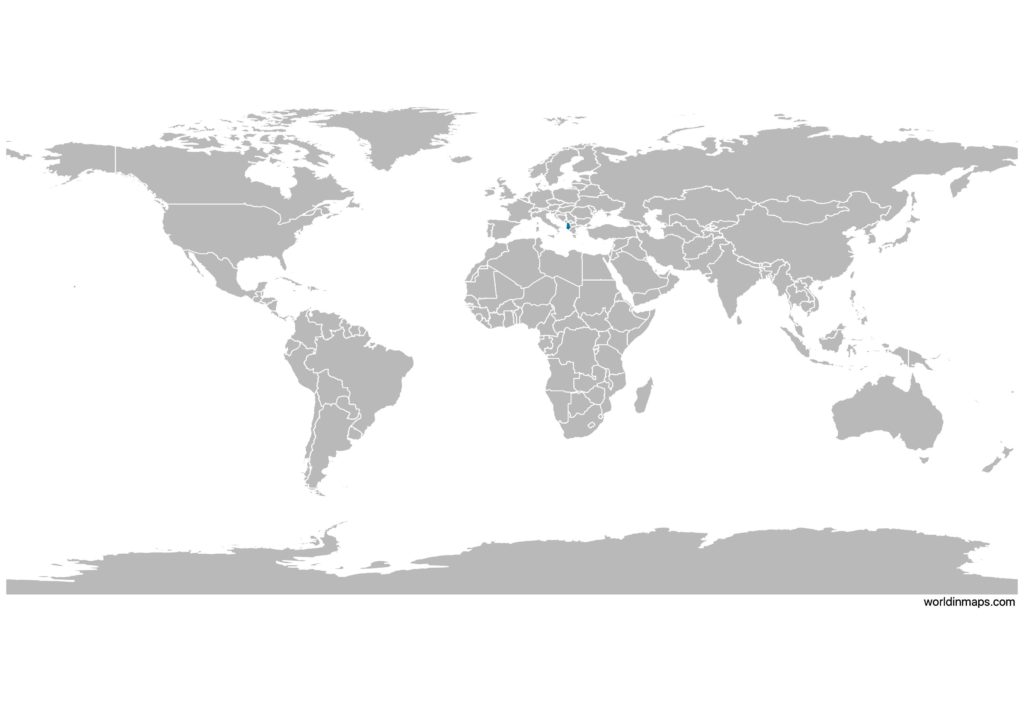
States and political map of Albania
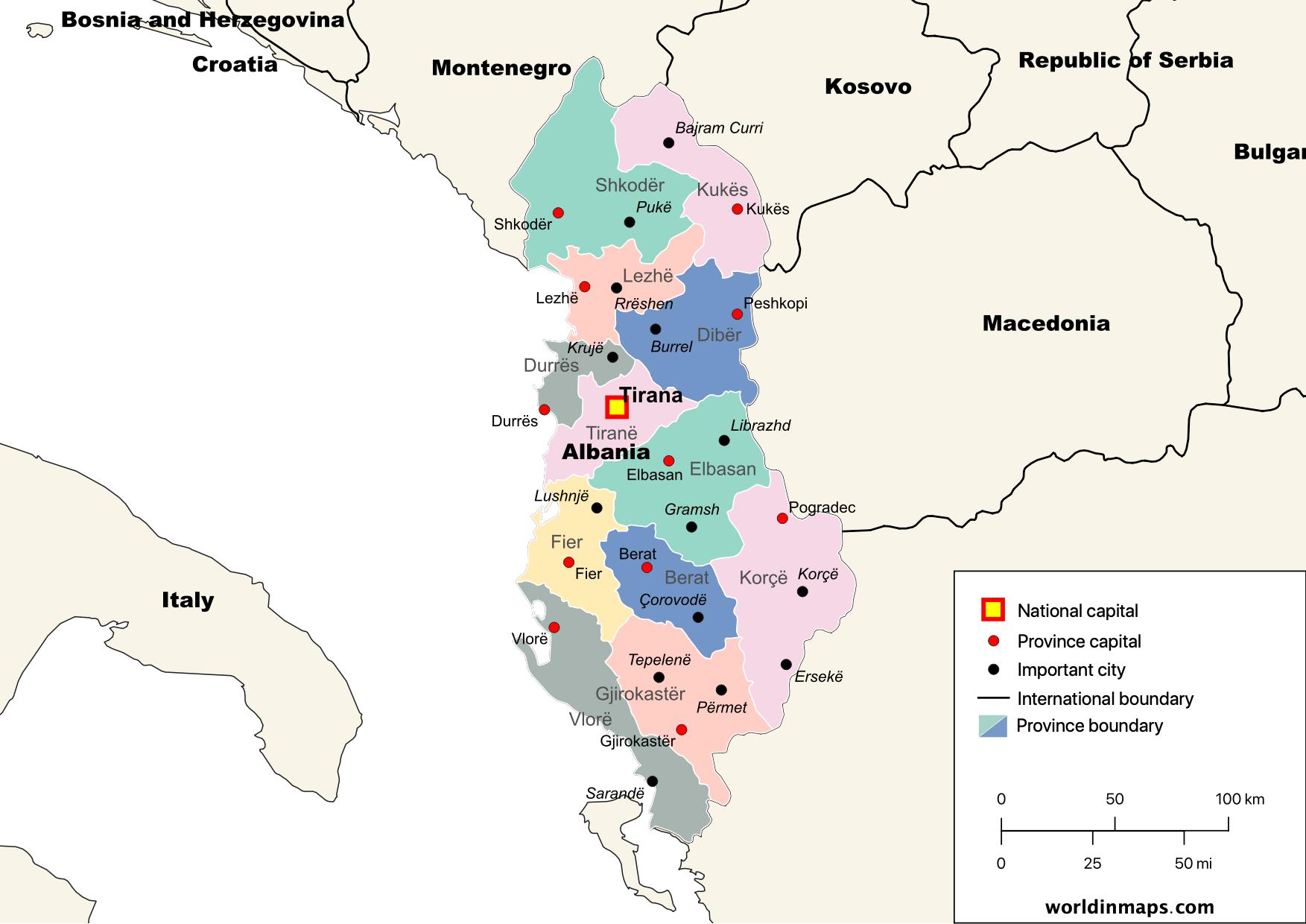
Albania is located in Southeastern Europe. It is bordering the Adriatic Sea and the Ionian Sea on the West. In the South, it is limited by Greece. In the East it has borders with Macedonia and Kosovo. Finally, it is limited in the North by Montenegro.
Albania has 12 provinces: Shkodër, Kukës, Lezhë, Dibër, Durrës, Tiranë, Elbasan, Fier, Berat, Korçë, Gjirokastër and Vlorë.
Physical map of Albania
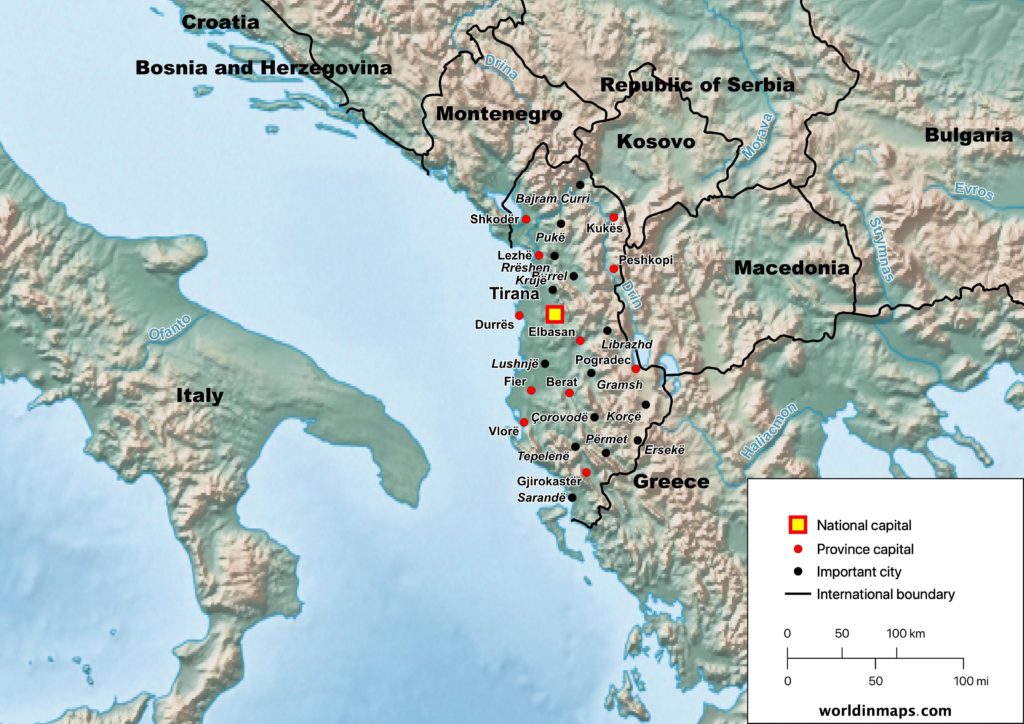
Cities, Railroads and road map of Albania
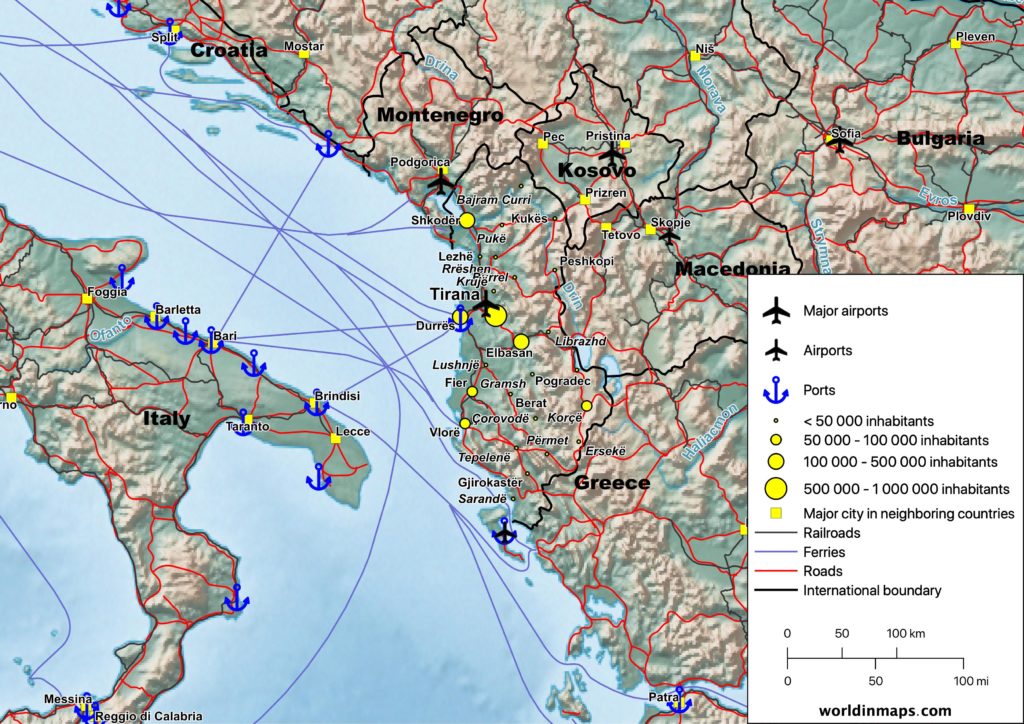
Albania top 10 largest cities (2011)
- Tirana (418,495)
- Durrës (113,249)
- Vlorë (79,513)
- Shkodër (78,703)
- Elbasan (77,075)
- Fier (55,845)
- Korçë (51,152)
- Berat (32,606)
- Lushnjë (31,105)
- Pogradec (20,848)
Demography
Population pyramid
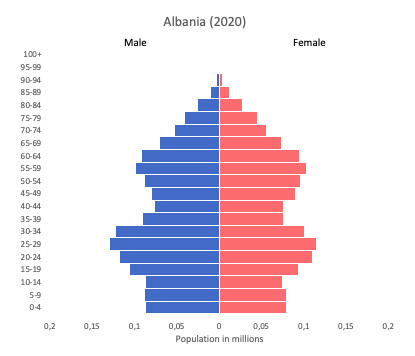
Age structure
Estimation for 2020:
- 0-14 years: 17.6% (male 284,636/female 256,474)
- 15-24 years: 15.39% (male 246,931/female 226,318)
- 25-54 years: 42.04% (male 622,100/female 670,307)
- 55-64 years: 11.94% (male 178,419/female 188,783)
- 65 years and over: 13.03% (male 186,335/female 214,276)
Remark: the age structure of a population affects a nation’s key socioeconomic issues. Countries with young populations (high percentage under age 15) need to invest more in schools, while countries with older populations (high percentage ages 65 and over) need to invest more in the health sector. The age structure can also be used to help predict potential political issues. For example, the rapid growth of a young adult population unable to find employment can lead to unrest.
Population from 1950 to 2020
Source: United Nations, Department of Economic and Social Affairs, Population Division (2019). World Population Prospects 2019, Online Edition. Rev. 1.
Evolution of the life expectancy from 1960 to 2018
Source: World Development Indicators, The World Bank
Economy
Agriculture:
wheat, corn, potatoes, vegetables, fruits, olives and olive oil, grapes, meat, dairy products, sheep and goats
Industries:
food, footwear, apparel and clothing, lumber, oil, cement, chemicals, mining, basic metals, hydropower
Exports – commodities:
apparel and clothing, footwear, asphalt, metals and metallic ores, crude oil, cement and construction materials, vegetables, fruits, tobacco
Imports – commodities:
machinery and equipment, foodstuffs, textiles, chemicals
Time in Albania
Go to our interactive map to get the current time in Albania.
Source:
- CIA World Factbook
- United Nations, Department of Economic and Social Affairs, Population Division. World Population Prospects: The 2019 Revision. (Medium variant)
- Wikipedia
1 data represent most widely spoken languages; shares sum to more than 100% because there is much bilingualism in the country and because respondents were allowed to select more than one language